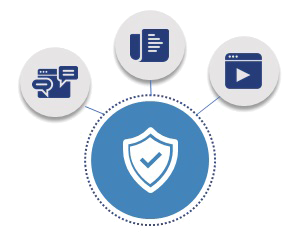How Improving Your Legacy IAM Solution Enables Business Change
Written August 22, 2022

Administrators are being forced to adopt new Identity and Access Management (IAM) approaches to mitigate risk as cloud-based applications, SaaS applications proliferate, and mobile, BYOD devices become more common. These changes affect access restrictions and data governance requiring a new approach to rights management. IAM applications and technologies such as a legacy on premise Active Directory Server may be unable to meet the demands of the evolving technical landscape and complex business requirements. New approaches and solutions offer varying degrees of access to different users in different contexts and real-time security checks that consider contextual factors. In today's IT ecosystem, it is more beneficial to apply tactics that take into consideration human qualities and environmental variables like time, location, and events which some legacy systems may not be able to do.
Legacy IAM Solution Pain Points
Legacy IAM solutions are focused on admin-time authorization and were designed to address the concept of a traditional network. They were not designed for a remote workforce with emerging technologies spanning multi-cloud and multi-geographic locations. They lack the capability required to cope with emerging technology problems in an efficient and planned manner.
Adoption of new technologies (cloud, mobile, collaborative support, etc.) requires support for dispersed identities. Distributed data, and enhanced security are among the additional challenges organizations encounter when adopting new technologies. Furthermore, legacy systems impede the implementation of new initiatives as they lack Policy Based Access Control (PBAC) capability, which is critical in today's complex IT ecosystem. Role Based Access Control (RBAC) is a primary example. In theory, Role Based Access Control (RBAC) seems like the ideal access model for an organization, however as organizations change to grow and stay competitive, it can be difficult to keep a tight grip on the model. In today’s reality individuals hold multiple roles, assume various titles and as organizations grow to the meet the evolving demand, new divisions and new groups are created, which makes it difficult for RBAC to scale.
Better Control of Access Privileges Is Required
Access creep, and over-permissions are two further problems that might arise from using end-of-life systems. With older solutions, many businesses wind up providing staff with improper access to systems, data, and applications. As a firm expands and as employees change roles, keeping access to a minimum to satisfy the specific needs of each employee is a critical IAM process, however it is time intensive and difficult to manage with legacy systems.
This issue is exacerbated when working with cloud-based services. Because legacy systems are role-based rather than contextual (or access-based), access techniques must include the capacity to supply various datasets, which can be challenging and costly with traditional IAM.
Operational Benefits of Change
Although adopting new IAM technology is expensive in terms of both time and money, the alternative cost of continuing to use legacy systems is much more expensive and should not be ignored. You will obtain the following benefits by updating your IAM platform:
More efficient use of the available funds
Legacy platforms usually call for costly customization. More recent systems are built with a faster deployment time in mind. You will be able to utilize all the efforts that have previously been spent on the legacy platform if you combine the two. This will allow you to solve your new difficulties quicker.
A higher level of safety
New identity access management systems incorporate contextual and real-time access, which helps to reduce risk by preventing "access creep" and efficiently managing shifting responsibilities inside businesses. This leads to achieving a greater degree of life cycle management.
Advantages for businesses
Sophisticated IAM systems offer adaptability, which enables businesses to embrace the technologies they choose and make the required adjustments as their businesses develop. These changes may be made more quickly and with fewer difficulties thanks to adaptable APIs and other features such as behavior analytics and zero trust. It all comes down to value addition and ensuring that you have the edge over the competition.
Technical Benefits of Change
Bringing your IAM up to date may provide you with the following technical benefits:
Policy on Top of Roles
Using dynamic policies to manage and regulate the expansion of roles is accomplished by adding ABAC (Attribute Based Access Control) to the already existing RBAC (Role-based Access Control).
Give Business Users Control of Policies
Employ dynamic context-based ABAC rules to deal with ever-changing regulatory and compliance obligations as well as reusable business policies. Easily give business users control of policies.
Access Based on Context
Context-aware choices should be added to the regular IAM access permits. Before allowing access to resources, contextual data about each authentication request is used to judge the session risk and the best policy to assign to the user. For example, if the users are signing in from an unknown location or device, multifactor authentication may be required before the user is granted access.
Secure API’s
Connect API access control to your existing identity access management software through a secure API.
Dynamically Control Cloud Resources
Go beyond simple provisioning by extending your identity and access management to the cloud.
Fine-Grained Support
Improve your identity and access management with granular control over resource access, based on the most stringent standards in the industry.
Planning to Upgrade
Businesses risk losing out security, compliance, and customer experience due to the drawbacks of legacy IAM systems, however, it is true that upgrading legacy systems involve both a clear strategy and money. It is a matter of reinventing the architecture from the bottom up to meet evolving technology requirements, as well as offering timely solutions that match business demands.
An IAM evaluation is a necessity for companies to complete before they can successfully adopt an all-encompassing and long-term IAM solution. Assessments assist firms in locating pain points and gaps within their IAM program and infrastructure and provide context for the reasons why specific IAM requirements are essential. Assessments also assist organizations in gaining a better understanding of the type of security that is required to support future development or shifting market conditions. From this assessment an organization can develop a technology roadmap which is an essential step to a successful IAM upgrade. The maturity of an organization's entire identity governance program, as well as its positioning to support business objectives and generate value, may be achieved with the help of an evaluation process.
While an organization can conduct its own assessment, it is recommended to utilize an experienced objective third party to assess an organization's IAM framework. A third party has the industry experts as well as an objective point of view which will benefit the organization overall.
Want to Learn More?
KeyData's flagship service is Identity and Access Management (IAM). We concentrate all our efforts on IAM. The KeyData advantage is based on our people and our knowledge. Our team is made up of a highly skilled group of engineers and consultants who specialize in Identity Governance and Administration, Privileged Access Management, Customer Identity, and Access Management, and Cloud Security Posture Management. Our team has a strong track record of providing end-to-end IAM services, from requirements gathering and roadmap development to full implementation, training, and managed support. Don't hesitate to get in touch with us right away for a free initial consultation.
References
7 Simple Steps to Modernize Your Legacy IAM. (2019, July 16). ForgeRock. https://www.forgerock.com/blog/7-simple-steps-to-modernize-your-legacy-iam
Gal Helemski. (2017). It’s Time To Modernize Your Legacy IAM. Plainid.com. https://blog.plainid.com/modernize-legacy-iam
GuidePoint Security. (2022, March 18). What Is Involved in an IAM Assessment? GuidePoint Security. https://www.guidepointsecurity.com/blog/blog-what-is-involved-in-an-iam-assessment/#:~:text=An%20IAM%20assessment%20evaluates%20a,of%20a%20business’s%20IAM%20processes.
Identity & Access Management (IAM) Assessment | Anexinet. (2018). Anexinet. https://anexinet.com/cybersecurity/identity-access-management-iam-modernization-assessment/
Lindgren, S. (2020, February 7). How to migrate your Identity and Access Management (IAM) system. Ubisecure Customer Identity Management; Ubisecure. https://www.ubisecure.com/identity-platform/how-to-migrate-iam-system/
LinkedIn. (2022). Linkedin.com. https://www.linkedin.com/pulse/role-based-access-control-rbac-good-enough-bhat-pmp-cism/
Mannarino, A. (2022). Identity and Access Management Assessment. Wwt.com; World Wide Technology. https://www.wwt.com/assessment/iam-assessment
Robb, D. (2022, January 27). Best Identity and Access Management (IAM) Solutions for 2022. ESecurityPlanet. https://www.esecurityplanet.com/products/best-iam-software/
Schedule Your IAM Assessment. (2019, August 16). Idenhaus Consulting. https://www.idenhaus.com/iam-assessment/





